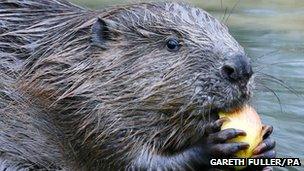Tayside is home to about 150 beavers, report says
- Published

Scottish Natural Heritage estimate there are approximately 146 beavers in the Tayside area
A report into the activities of beavers in Tayside has estimated there are about 150 of the animals in the area.
Scottish Natural Heritage (SNH) had commissioned the study to examine the status of the beaver in the Tay region.
The body estimates there are 38 or 39 groups of beavers in the Tay area, equating to approximately 146 animals.
SNH has recommended the introduction of beaver mitigation schemes, to minimise the impact of the animals on the local environment.
The European beaver, Castor fiber, became extinct in Scotland sometime during the 18th century as a result of over-hunting.
Several surveys
It is believed the current wild beaver populations in Tayside are the descendants of escapees from private collections in Angus and Perthshire over the past decade.
The SNH study combined the results of various field surveys carried out between 28 May and 6 July this year, with other longer-term beaver observations.
The results suggest there are 0.14 - 0.15 beaver groups per km of waterway in the Tay River catchment area.
SNH said their survey had found that only three beaver groups had built dams in the area.
They said seven dams were currently maintained by the animals and that the dam-building activities of two of beaver families had led to localised issues, resulting in the landowners removing the dams.
However, SNH also found that the local fishermen and gillies, consulted in the study, had no problem with the presence of beavers, and even claimed the presence of the mammals enriched the fishing experience.
Scottish Natural Heritage said the study showed the need for further monitoring of the beavers' activities and called for annual repeat surveys to gauge the persistence, growth and spread of the current beaver population.
SNH also recommended the introduction of trial mitigation schemes to allow humans and beavers to coexist.
The mitigation methods suggested include installing flow-control devices at problem beaver dams, protecting large or valuable trees next to rivers where beavers are felling trees and protecting beaver lodges from being washed away in order minimise beaver construction activity.
Managing beavers
Following the report, David Bale, chairman of the Tayside Beaver Study Group, called on land owners affected by beavers to contact them.
He said: "For the first time, we have a clear picture of how many beavers there are and how far they have spread. As the beavers are in an area with both farming and fishing, this is a good chance to see how beavers may affect land use.
"We encourage land managers to contact the Tayside Beaver Study Group if they have any issues with the beavers on their land.
"The group is keen to advise on non-lethal ways of managing problems arising from dams and burrowing in banks, as well as helping protect valuable trees."
Ian Mackintosh, from the National Union of Farmers in Scotland, added: "The next two years must be used to provide the study group with evidence as to the lifestyle and habits of the beavers and their relationship to other land uses in the area.
"It's also important to gather as much detail on the health status of the animals to ascertain if they are harbouring any diseases which might be difficult to control.
"Farmers live in harmony with many species, but if it emerges there are conflicting issues, we must be able to mitigate timeously and without undue bureaucratic burdens."
- Published23 October 2012
- Published4 September 2012
- Published4 May 2012
- Published16 March 2012